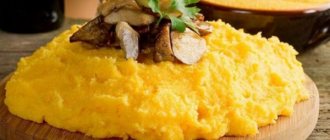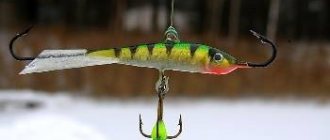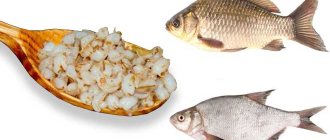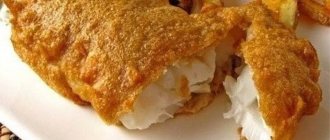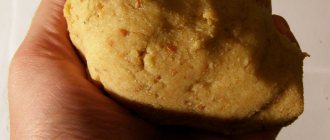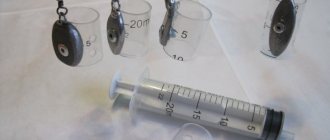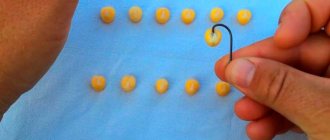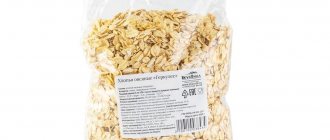Corn has long been one of the favorite delicacies of carp fish. This is probably explained by the fact that during the harvest season, when it was still called the “queen of the fields,” a lot of grains ended up in reservoirs and there, one way or another, they went to feed the fish.
That's why fishing with corn is so widespread. In addition to whole boiled or steamed grains, many anglers are familiar with the use of canned corn and use corn porridge - hominy - as a hook bait.
Cooking recipes
Hominy for fishing is cooked in different ways, but basically everyone uses a recipe in which wheat flour is added to corn flour. Wheat flour improves the plasticity of porridge, allowing you not only to cut it, but also to roll it into balls. Previously, we tried adding gelatin or cotton wool to make hominy baits stronger, but a mixture with regular flour turned out to be the simplest and most popular way to make this fishing bait.
Basic recipe for mamaliga
Ingredients:
- Corn flour - 3 parts.
- Wheat flour – 1 part.
- Water.
- Flavors.
To prepare corn bait, we also need a saucepan and two plastic bags.
The procedure for preparing mamaliga is as follows:
- Fry both flours in a clean frying pan; this will give the future porridge a more pronounced aroma.
- Mix both flours in a ratio of three to one.
- Stirring constantly, pour water into the dry mixture until the consistency becomes similar to sour cream.
- At the same time, various flavors, previously dissolved in water, are introduced into the mixture. Additives such as ground seeds or similar bulk ingredients cannot be used, as this can ruin the consistency of the hominy.
- We transfer the prepared and flavored mixture into two bags - insert one filled one into an empty one, and carefully tie both. We use two bags for strength and as insurance against accidental rupture.
- We put this double bag in a saucepan and fill it with water so that it completely covers the bag.
- After boiling, cook the porridge for thirty to forty minutes. The longer the hominy cooks, the denser it will be.
- After the required cooking time has passed, turn off the heat and let the porridge cool in the pan, without draining the water.
The finished porridge can be delivered to a pond without removing it from the bags in which it was cooked. You can cut it into pieces or roll it into balls when you start fishing.
For spring feeders and "methods"
This recipe contains only corn flour and water, and one liter of water is taken per kilogram of flour.
- Pour water into a saucepan and bring to a boil.
- Pour the flour into the water in a thin stream, stirring constantly.
- After adding all the flour, turn off the heat and stir until the porridge cools.
Pancakes
From the porridge obtained in the previous recipe, we make small pancakes one centimeter thick and boil them in boiling water until they float. Now these pancakes can be cut or made into balls for bait and used for fishing. This bait holds well on a hook not only in a standing body of water, but also on a river.
From corn sticks
This bait can hardly be called hominy literally, but the recipe is worth attention:
- Take one and a half dozen large corn sticks and pour boiling water over them until a liquid porridge forms.
- Add 3-4 sugar shortbread cookies to the resulting porridge.
- Knead the mixture with your hands, adding white bread crumbs to give elasticity.
- At the end, add a drop of honey for flavor.
The main ingredients for preparing mamalyga for fishing
Fishermen often ignore modern methods when they use all kinds of baits and baits sold in specialized stores. Professionals in the interesting and fascinating subject of fishing use proven methods that really work and fish with hominy. Preparing hominy for fishing quickly will not be a hassle. Such boiled porridge is actually a universal bait, when the fish that bites will sit well on the hook.
Mamalyga is a tasty, aromatic and soft kutia of bright color. The dish can be eaten and used as bait during fishing. To prepare such porridge, you need to buy the main food ingredient - finely crushed corn. Many fishermen do not limit themselves to this and add wheat flour to the brew. It is needed as a fastening element so that the bait stays well on the hook. This component must be added to hominy if the fisherman has expressed a desire to fish in the current.
Fishermen in the southern regions of the country often use a bait called hominy to catch white fish.
Flavors for hominy
Mamalyga itself smells good from a human point of view, and also to the taste of fish. However, to enhance the aroma and attract fish during cooking, various additives are added to the porridge, for example:
- sugar;
- honey;
- strawberries;
- raspberries;
- vanilla;
- cocoa;
- coffee;
- banana;
- and other sweet tastes.
As mentioned above, it is advisable to dilute all flavors in water before adding them to the mixture, so as not to disturb its consistency.
On the pond
Let us now consider the methods of baiting and feeding from the resulting hominy. If the bait turns out to be too dense, then before you start fishing, you need to cut the porridge into cubes with a clean, dry knife on a board.
Softer hominy can be rolled into balls. It is also advisable to fill the feeders with soft porridge. To attract fish, you should dip a feeder filled with such bait into the loose mixture. This will give the effect of dusting under water and increase the success of fishing.
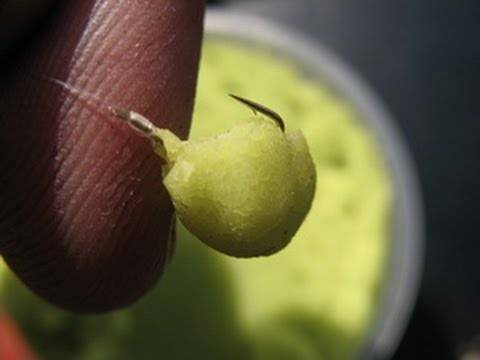
When equipping “method” feeders, the hominy is tightly packed, and a hook is inserted into it either without bait at all, or with a couple of grains of boiled corn; you can also put on a foam ball as a provoking bait.
How it works? A carp or crucian carp, sucking on the method nipple, will certainly be hooked on the hook hidden in the bait, either by swallowing the offered grains, or by passing the hook through the gills as an annoying nuisance.
lovlyavsem.ru
Technique and strategy for fishing with hominy
Mamalyga is a fairly tasty product, which attracts them quite often. First of all, it is necessary for the fish to feel it, and then it’s all about technique. It is worth noting that it is quite tasty and until it is taken off the hook, it will not lag behind, so you should carefully monitor the float.
As soon as the fish starts to bite, you should act immediately, because this is a very fragile bait that can be quickly taken off the hook. It will be difficult for an inexperienced fisherman to fish with it; he will have to put the bait on the hook again several times before getting the desired result.
Among all the variety of baits and baits, corn porridge looks very attractive. It is good for its bright color, rich taste, rather strong smell - carp and bream, crucian carp and carp, roach and rudd, ide, chub and even perch respond well to it. At the same time, corn porridge has a high density, so it is equally convenient to use both as bait and as a bait.
And its preparation is inexpensive, so even a novice feeder needs to know how to cook hominy. Just pay attention, hominy and just corn kernels are not the same thing. These are baits with very different structures, plus, porridge can be an excellent bait.
In addition, the preparation also has its own characteristics - it is important to make it with a rich taste and a good smell. It is necessary to get a very dense porridge that will sit securely on the hooks and will definitely not fall off when casting.
Requirements for porridge
How many fishermen have so many opinions on how to cook porridge from corn flour, but everyone is unanimous in one thing - it attracts fish. Therefore, there are special requirements for the finished product - it must be moderately soft and plastic. At the same time quite dense. It is precisely these qualities of the porridge that will make it easy to handle it, hide the hook in it and not let it fly off the hook while casting the fishing rod.
All porridges are cooked according to the same scenario - pour the cereal into water and wait for the liquid to boil away. But this method has one drawback - dirty dishes due to burnt food.
In order for the porridge to stay on the hook, it must be thick and dense enough. But often, after cooking, the porridge turns out crumbly, which means that there is a problem in giving it the required shape.
That is why many fishermen have adopted a new method of preparing bait for fishing. It is distinguished by the simplicity of the process, the absence of unforeseen consequences and successful fishing.
Who's into corn porridge?
Fishermen with many years of experience use a ready-made brew if they want to catch:
- carp;
- rudd;
- bream;
- crucian carp;
- ide;
- chub;
- carp;
- roach.
Fishing with hominy is very popular in the southern regions of the country, but professionals in this business who live in the middle and northern latitudes know the secret of the success of porridge very well and prefer to take it with them when fishing.
The bright color and aroma of hominy can even attract perch and other fish living in the pond. Corn kutia has plenty of advantages:
- easy to roll into small balls;
- apply to different gear;
- many river inhabitants willingly peck after bait;
Read more
How to prepare makukha for fishing with your own hands?
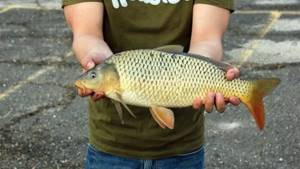
A fisherman's catch may contain different types of fish.
- inexpensive option as bait;
- can be used in summer, spring, autumn;
- a wide variety of recipes;
- holds well on the hook.
It makes sense to add one more item - cooking time.
Simple features of cooking porridge
So, everything is quite simple. Thoroughly mix wheat and corn flour in equal proportions. Add enough water to make a dough with a consistency similar to pancake dough. Carefully transfer it into a bag, tie it and place it in a pan of water, which we put on the fire. There is a nuance here. The bag of porridge must be constantly in the water, and the countdown of the cooking time begins only after it boils. Upon completion of the cooking process, do not rush to immediately remove the bag from the dish. Allow the food to reach and cool while in the liquid. Porridge should be cooked before going fishing, and not for future use. You can print the package already at the fishing spot. Take it a little at a time and secure it on the hook. To prevent it from sticking to your hands, you need to slightly moisten them. Further, depending on the time of year, the type of fish, and the preferences of the fisherman, the porridge is given a certain taste and smell to attract fish.
That's the whole trick of this simple method of cooking bait or bait for your future catch.
www.sky-blog.net
Making hominy with your own hands
Properly prepared hominy should have a bright color and an appetizing smell and taste. Therefore, all ingredients must be fresh, and dishes and hands must be clean. In addition to these requirements, the hominy must sit well on the hook and slowly wash out of the feeder in the water. This is especially important if fishing is carried out over long distances.
There are many different recipes for hominy for fishing, which differ in preparation time and degree of complexity. Which one to choose depends on the fisherman himself.
Recipe No. 1
This cooking method takes a long time; it is better to cook in the evening if fishing is planned for the morning. The bait is perfect for feeder fishing.
To make such hominy, you need to take:
- corn flour - 3 parts;
- wheat flour - 1 part;
- thick plastic bag;
- flavoring;
- container with water.
Preparation procedure:
- Both types of flour should first be fried in a frying pan to give a pleasant taste.
- Measured volumes of corn and wheat flour are thoroughly mixed.
- Water is added to the container with the mixture with constant stirring.
- As soon as the dish becomes like thick sour cream, stop adding water.
- The resulting consistency can be flavored with a sweet flavor.
- Now the contents of the container need to be transferred to a thick plastic bag (you can use 2 thin bags).
- The dough ball is tightly wrapped and placed in a pan of water.
- Next, the pan is sent to the stove, and the porridge is cooked for 30-40 minutes. To increase the density of the bait, the heat treatment time can be increased.
- When the hominy is cooked, it is left to infuse overnight in the same container with water.
When fishing, you can take bait in a bag, which will protect the porridge from souring. The bait can be cut into cubes or rolled into balls.
Recipe No. 2
This method is quite simple and fast. The resulting porridge is suitable for fishing with a donkey with a spring.
The only ingredients you will need are:
- corn flour - 1 l;
- water - 1 l.
Preparation procedure:
- Water is boiling in a clean saucepan.
- As soon as the water boils, corn flour is poured into it while stirring constantly.
- When the flour is completely poured out, the heating is turned off and mixing continues.
- After cooling, the hominy can be rolled into balls and also filled into a feeder.
- The consistency of the resulting hominy should be slightly softer than plasticine.
Recipe No. 3
Hominy prepared in this way is universal. It can be used on standing reservoirs, as well as on rivers with strong currents.
First you need to prepare the corn pancakes. This requires:
- corn flour - 1 part;
- water - 1 part.
Procedure:
- Flour is poured into boiling water with constant stirring.
- Cover the pan with a lid and turn off the heating.
- After 5 minutes, pancakes with a diameter of 7-8 cm and a thickness of about 1 cm are molded from the resulting porridge.
- The pancakes are lowered into boiling water, where they cook for 2-3 minutes after rising to the surface. After this they are removed from the water.
- Once the porridge has cooled, it can be used for fishing on lakes and ponds.
To be able to fish on a river with a strong current, you need to add 1 cup of semolina or 0.5 cup of wheat flour to 0.5 liters of corn flour. The prepared hominy should be kneaded well with your hands, wetting your hands with unrefined sunflower oil.
How to prepare mastyrka - a bait based on peas and semolina, which carps love so much.
How to prepare delicious boilies for catching large fish - read this detailed guide with several recipes.
Recipe No. 4
An original way to quickly prepare bait. To make bait, you need to take the following components:
- corn sticks – 12-14 pcs;
- ground sugar cookies – 3 pcs;
- crumb of white bread - to give elasticity.
Corn sticks are placed in a deep plate and poured with boiling water. Ground biscuits are poured into the resulting liquid porridge. Now mix the dough with your hands and add white bread crumb until the bait becomes elastic and stretchable. At the final stage, honey is taken from the tip of a knife and added to the hominy.
Cornmeal hominy recipe for fishing
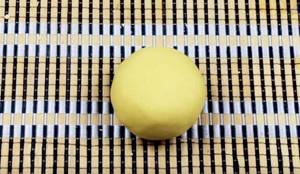
In the southern regions of the Russian region, corn porridge with the interesting name mamalyga is very popular. In addition to being used for its intended purpose, it can be used to make a “catchable” bait for catching white, peaceful fish.
For the bait to be “working”, it must have a dense consistency, smell pleasant, and stay on the hook perfectly.
Hominy is caught not only with float gear, but also with feeders and donks. When fishing with English donkey, the corn mixture is both bait and complementary food.
A few words about the bait
Canned corn is simple: choose a product among dozens of “brothers” standing on store shelves, open it, and fish to your heart’s content.
But with corn bait you will have to tinker a little, however, the result can exceed all expectations.
Most fishermen cook hominy bait themselves, fortunately there are a whole bunch of recipes. You need to approach the process of preparing bait thoughtfully, having conducted a preliminary analysis of the taste preferences of the fish inhabiting a particular body of water.
The huge advantage of making this bait yourself is that the fisherman can create various flavored mixtures.
Corn grains and hominy are two completely different baits, although the original product seems to be the same.
In most cases, the grains are attached to the hook, but the hominy bait “works” perfectly both when attached to a spring, and when equipped with a hair rig, and when mounted on a hook.
In addition, dense balls made from porridge can additionally be used as bait for the fishing point.
Tips for cooking hominy from experienced fishermen
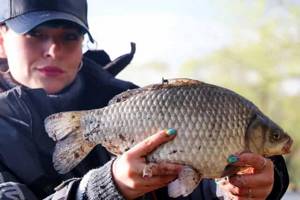
To make your fishing successful, listen to the advice given by experienced fishermen.
Here they are:
- You need to prepare the bait in a good mood. This way it will absorb the positive energy of the owner, and, undoubtedly, the fish will like it more than a product that was prepared in upset feelings.
- The “correct” hominy should be aromatic and have a bright color. This will happen if fresh, high-quality products were used for cooking, and the dishes and hands were clean.
- For long casts, as a rule, a feeder is used. To prevent the bait from flying off the hook and being washed out of the feeder not immediately, but after a given time, you need to have several bait options in stock - this way you can choose a more effective option on the spot.
Each fisherman has his own recipe for making corn bait, proven over the years. Some people treat the cooking process carelessly, “carelessly,” while for others, cooking resembles an oriental ritual with many subtleties that complement each other.
There is another category of fishermen whose “hands do not grow from there.” They don’t know how to cook, so they have to ask relatives or friends. Which category of fishermen do you belong to?
Corn porridge can be held together in different ways: some add gelatin for density, others mix it with cotton wool. And all this to ensure that the bait does not fly off the hook. There is a universal recipe that allows you to prepare porridge for all occasions.
Useful and interesting:
Tricky fishing tackle - Bologna.
How to quickly and easily cut off small things while fishing.
Flavors
Adding flavors to hominy does not have unequivocal support among culinary anglers. Some remain supporters of the clean and natural smell of corn, which attracts fish. Other anglers are looking for a magic additive to make hominy even more irresistible.
Acceptable flavorings include natural products that have a familiar odor to fish. These ingredients include:
- Vegetable oil. It is added at the dough kneading stage, or used at the final manual kneading operation.
- Sunflower cake or ground seeds. It is used to attract fish with its particles. In the center of the bait ball there is hominy, and the surface is covered with dry bait.
- Sweet additives. Many members of the carp family love sweets. To give hominy a sweet taste, the following are used:
- honey;
- strawberry or raspberry syrup;
- vanilla;
- sugar;
- banana and coffee bean extract.
The best period for using hominy is considered to be the warm and hot season. This period can begin in mid-spring and end in early autumn. During the cold season, hominy loses its attractiveness to fish.
ranoutrom.com
Top corn lovers
The biggest fans of corn grits bait among the inhabitants of reservoirs are carp fish. And what’s interesting is that it is the large specimens that prefer corn bait of all types.
The corn fraternity includes:
- carp;
- carps of all varieties;
- Amur;
- crucian carp;
- roach and rudd.
It is they who react most vividly to the presence of this bait in their feeding areas.
The interesting thing is that these fish eat any corn product. This includes young corn grains, boiled and raw, and steamed and hard corn grits, and a mass made from its own flour.
There is no single recipe for preparing corn feed. Each region, each village has its own characteristics of preparing this product. It is prepared both as a separate bait and as part of a complex bait. When preparing, fishermen use various components. Of course, now fishing stores sell a lot of baits, as they say, for every taste. And they are beautifully signed, this one is for crucian carp, this one is for carp, this one is for asp. But still, there is no better bait than one prepared with one’s own hands.
Dry groundbait from cereals
You need to know how to prepare a simple fish bait using the corn grits you have on hand. If it exists, of course. In principle, this is not a problem now; crushed corn is sold in any grocery store.
For preparation you will need:
- crushed corn grits;
- sunflower cake;
- a spoon of sunflower oil;
- semolina.
Do-it-yourself bait from good crushed corn grits is very effective.
Cooking method
Everything is as simple as possible here. For 2 shares of cereal, take 1 share of cake and ½ share of semolina. The cake should also be free-flowing. Everything is thoroughly mixed until dry. Add a spoonful of oil and mix again. Privada is prepared in the evening. This is necessary so that it sits overnight and the smells mix. Pour the bait into a bag and take it fishing in the morning.
Application
Upon arrival at the site, pour the mixture into a bucket or other container. Pour the mixture with a small amount of water and let it stand for 5-10 minutes, and then, scooping it by the handful, scatter it at the points of intended fishing.
This method is only suitable for bodies of water that do not have a current. On rivers with the slightest current there is no point in using dry bait, it will immediately be carried away.
Bait made from steamed and boiled cereals
To prepare boiled bait, you can use both whole young corn as bait and crushed corn grits. They must be prepared in a certain way.
There are two ways to prepare corn bait:
- Cooking.
- Steaming.
Cooking is used for feeding during the current. Privada with boiled components made from corn flour is well formed into dense balls and does not break instantly when it gets into water. That is, they are not immediately carried away by the current, but are gradually eroded, creating a feeding area for the fish.
Of course, you can’t use it as bait, but corn grits are ideal as bait.
Cooking by boiling
In this case, the crushed grain (1 kg) is poured into a saucepan with water and placed on low heat. After boiling, you need to cook it a little, about 5-8 minutes. A minute before turning off, add a glass of plain, or better yet, corn flour and cook for another minute. Add 2 cups of cake and a glass of flour to the hot porridge. Pour in ¼ sunflower oil. To stir thoroughly. You can add anise or dill flavoring. Immediately form into balls and leave until morning.
Steaming
This fish bait is suitable for both current and standing reservoirs. In this version, the cereal is not boiled, but poured with boiling water. The container with bait should be wrapped in a blanket for a couple of hours. Soak stale bread in warm water until completely limp. Add dry flour to the bread and mix thoroughly. As in other options, add sunflower oil.
Separate about 1/3 of the mixture and set aside, adding a little flour and fresh white bread crumb. After thorough kneading, you will get a mass with the consistency of plasticine. This is good bait.
Pour the remaining majority of the mixture into a container with corn bait and mix well. You can leave it in a cool place until the morning.
Application
These two species, in addition to being used as loose bait on the bottom, are also very good for filling feeder feeders.
As for the rest, just throw balls of boiled cereal prepared the night before at the fishing points or form looser ones from steamed corn on the spot and feed the points. And you can start fishing.
orybalke.com
How to prepare porridge for a spring
There are many options for preparing porridge for feeders such as spring feeders. At the same time, there are recipes that deserve attention. Cooking porridges should be accompanied by a number of recommendations, taking into account the specifics of the equipment. For example:
- You can add all kinds of flavors to the porridge. At the same time, you should not get too carried away, especially with artificial components, so as not to scare away the fish.
- It is very important to achieve the right consistency: it should not be too viscous or too crumbly. If the porridge is too viscous, it will not dissolve well in water, and if it is too loose, it will fly out of the spring when it hits the water. Therefore, cooking porridge, although simple, is a crucial moment.
- It is permissible to add sunflower cake to any porridge, which will serve not only as a flavoring agent, but also as a leavening agent. You can use it to adjust the thickness of the porridge.
- During the cooking process, you should ensure that the porridge does not burn, therefore, it is better to cook it over low heat, stirring constantly.
How to properly cook corn porridge in water
If corn porridge is to be used as a side dish, then it is better to cook it in water. To do this you will need a set of the following products:
- 2.5-3 glasses of water
- 1 cup corn grits
- butter and salt to taste
- Pour the corn grits into a colander and rinse thoroughly under running water.
- Boil water in a thick-walled saucepan and add salt.
- Pour the washed cereal into boiling water, add salt, and mix well. When the porridge boils, cover the pan with a lid and simmer for at least half an hour over low heat, stirring regularly so that the porridge does not end up with a burnt smell.
- After 30 minutes, you can turn off the heat, since the cereal will already absorb all the water. Then you need to add butter, stir and, for the porridge to ripen, wrap the pan in a towel.
If the dish is complemented with fried mushrooms with onions or sweet peppers with tomatoes, then it will become a real delight.
Recipes for the best porridges for spring
Millet porridge for fishing on a nipple
Millet porridge is considered one of the most popular because it is considered the most universal bait. It is used when it is necessary to attract fish with small fractions. Most types of peaceful fish, such as tench, carp, roach, crucian carp, etc., are caught using millet porridge.
The recipe is simple:
- A glass of water is poured into the container and brought to a boil.
- Pour two glasses of cereal into boiling water.
- The porridge is cooked for about 15 minutes, with constant stirring.
- After this time, the porridge is removed from the heat and left for some time (until it cools).
- You can add a little feed to the porridge, which will increase its viscosity.
Millet porridge consists of small fragments that are quickly washed out of the spring. This factor must be taken into account and the porridge carefully compacted into the spring. Millet is also added to other cereals to obtain combined baits. Since millet is washed out much faster than other ingredients, it can create a food cloud to attract fish. Millet is added to corn or pea porridge, and also combined with wheat flour.
Pea porridge for spring fishing
Cooking pea porridge does not require much effort, but its preparation is more expensive. As a result, you will get a catchable bait that will be of interest to many species of fish, especially bream. Every fisherman knows that bream is partial to peas.
It is prepared as follows:
- 1 liter of water is poured into the container and one glass of peas is added. The container is placed on the stove, and the fire is reduced to a minimum.
- After the water boils, you need to make sure that the peas do not burn. To do this, it is constantly stirred.
- As the peas cook, you need to constantly remove any foam that has formed. So the peas should cook for about 10 minutes.
- After 10 minutes, the heat increases and the porridge is covered with a lid.
- After 5 minutes, half a teaspoon of soda is added to the porridge, followed by stirring the component. Baking soda allows the product to cook faster.
- As a result of cooking, the peas turn into a liquid mass (they are digested). 100 grams of millet are also added here.
- After 10 minutes, sugar and salt are added to the porridge, one teaspoon at a time. The result will be a more catchable bait.
- Finally, a small amount of flour is added to the porridge.
This porridge, due to its consistency, is perfect for catching fish with a spring.
Mamalyga (corn porridge) for fishing with a spring
Mamalyga is a porridge made from corn. It is distinguished by its catchability and ease of preparation. Some types of fish like corn porridge, such as crucian carp, carp, carp, etc.
How to prepare mamaliga:
- First you need to take 300 grams of corn flour and fry it in a frying pan. At the same time, you need to control it so that it does not burn.
- About 100 grams of wheat flour is added here, after which the corn and wheat flour are further fried together.
- After an attractive smell appears, the flour mixture is filled with water. In this case, the fire must be turned off and water added in small portions.
- After 10 minutes, the porridge will turn into a thick viscous mass. If desired, you can add a little flour to the porridge.
- The porridge is removed from the stove and must cool before further use. Then it is divided into 2 parts and placed in sealed plastic bags.
- The bags are placed in a container and filled with water, after which they are boiled for about half an hour.
- The mamalyga is removed from the heat and left overnight. After this, the water is drained, the porridge is freed from plastic bags and cut into cubes or balls are formed from it, with which the spring is filled.
Porridge from mixed feed for spring fishing
Compound feed is a mixture of waste obtained from processing various grain crops. The cooking process is also not complicated, but it needs to be controlled. The main thing is to get the porridge of the required thickness.
To prepare porridge according to this recipe, you need:
- First of all, you need to boil the potatoes in their skins.
- Pour 2 liters of water into a container, put it on the fire and bring to a boil.
- In the same container, add half a kilo of feed and cook for 10 minutes, with constant stirring.
- The crumb of rye bread is taken and added to the porridge.
- Take a couple of the largest potatoes and knead them to a puree, after which they are also added to the porridge.
- Add a tablespoon of sunflower oil to the porridge and mix thoroughly.
- The porridge will turn out more attractive if you add just a little vanillin to its composition.
If the porridge is prepared correctly, you should get a thick, viscous mass from which you can roll into balls and fill the feeder (spring) with them.
Semolina porridge with rolled oats on a spring
Semolina is added to many bait recipes; in addition, crucian carp and other fish of the carp family are actively caught using ordinary semolina. If you prepare semolina porridge with rolled oats, you can get a universal bait.
The preparation is not complicated and consists of the following steps:
- Take two glasses and pour semolina into one of them, about halfway, and pour water into the other, a little more than half a glass.
- The water is sent to a container that is placed on fire. The water should boil.
- After the water has boiled, oatmeal is poured into the water, in the proportion: a teaspoon to half a glass of water.
- Add a teaspoon of sugar here and mix.
- After white foam appears on the surface, the prepared semolina is poured into the container, not in large portions, with stirring.
- After all the water has been absorbed, the porridge should be gently pressed down on top, and the container itself is placed in a towel and left in this state for 15 minutes.
- Then the whole mass is thoroughly kneaded so that there are no hard lumps.
- You can add a couple of drops of anise oil as a flavoring.
How to prepare hominy for fishing?
There are plenty of ways to cook aromatic porridge for fishing, but one of the prerequisites is clean dishes. Many fishing enthusiasts change the consistency and add their own ingredients and flavorings to make the brew brighter, denser and more tasty. Here we will consider the most effective and field-tested recipes for preparing hominy for fishing, with the help of which fishermen managed to bring home a rich catch.
To prepare a delicious brew for fishing you need to purchase:
- corn and wheat flour;
- two transparent plastic bags;
- Additives: raspberry, strawberry.
Stainless steel utensils will be required. Take corn flour and wheat flour in a ratio of 3:1. Pour everything into a frying pan and fry in sunflower oil. Make sure that the ingredients do not burn, add water, mix thoroughly, achieve a thick consistency similar to cream. Add the extract at the same time. If you couldn’t buy it, you can add vanilla sugar or honey.
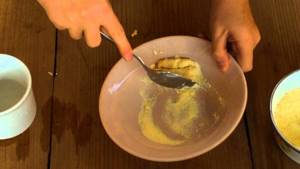
In fishing, ordinary corn porridge can only be used as bait
Fold the purchased plastic bags one into the other, place the hominy inside and place it in a pan filled with water so that the liquid covers the wrapped bag. Next you need to cook the resulting kutya. If you need to cook hard porridge, you will have to cook it for about 40 minutes. After the allotted time, the container should be removed from the stove and the bait should be allowed to brew for 1-2 hours. It is advisable to unwrap the bags while fishing so that the dough does not sour and the appetizing smell is preserved.
A quick recipe for hominy for fishing - bottom fishing
There is an option to cook traditional porridge for fishermen who prefer bottom fishing. The method is interesting and, according to those who like to sit with a fishing rod by the river, effective.
To prepare the dough you need to purchase:
- corn, wheat flour;
- puff bread;
- jam or jam.
Soak the bread with purchased sweets and knead wheat and corn flour for cooking, as described above, but in this process you need to add jam or jam mixed with puff bread into the brew to achieve a thick consistency.
Read more
How to catch perch using a balance beam?
The high density of kutya, boiled for 15 minutes, allows the dough to be used for bottom fishing and specifically for feeder fishing. You can also feed the fish with cooked hominy, but not by adding it to the feeder, as it will clog the feeder bait. It is better to put the finished mixture on top rather than inside. If you prepare porridge according to the recipe described above, you can successfully catch carp.
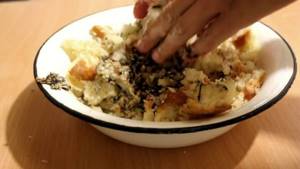
Properly made hominy stays on the hook perfectly
A quick recipe for mamalyga made from corn grits for fishing
There are ways to prepare delicious dough in the shortest possible time if you don’t have time to cook traditional kutya for 30-40 minutes to achieve its characteristic density.
You need to buy similar ingredients:
- corn flour;
- two plastic bags;
- pot;
- raspberry, strawberry flavoring.
No frying required here. Add flour and flavor enhancers to boiling water in portions with constant stirring. When it is clear that the consistency is similar to cream, the porridge is transferred to plastic bags folded in half. The bag is wrapped.
This is the fastest, most effective recipe for preparing dough, but you should remember that corn for fishing will be slightly plastic and will be suitable for bait and fishing. It is not difficult to roll a hard ball for a hook from such a brew; kutia is equally suitable for spring-type feeders.
Universal recipe for hominy for fishing
Every person who likes to sit with a fishing rod wants fish to bite well on cooked corn porridge:
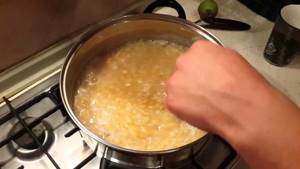
A properly prepared bait should have a fragrant smell.
- bream;
- rudd;
- roach;
- carp;
- crucian carp;
- perch.
To do this, you need to prepare a special dough, where healthy ingredients are combined in different proportions. This recipe for mamalyga for fishing exists when the following is mixed in during the preparation of kutya: sunflower oil, roasted coffee beans, honey. Experienced fishermen add a little banana to enhance the smell, so that the taste is rich.
The versatility of the recipe lies in enhancing the taste and smell due to new aromatic additives when there is a chance to catch a lot of different fish.
After preparing mamalyga with the above-described ingredients, directly at the fishing site when rolling the balls, you need to add grated seeds or stick the crushed grains around the lump. In the reservoir they will separate and become an interesting bait for carp, crucian carp, and roach.
Original recipe for mamalyga
There are dozens of fish baits based on corn porridge. Many recipes are positioned as original when unusual ingredients are used, from the point of view of an amateur fisherman.
Read more
How to choose a lure for trout?
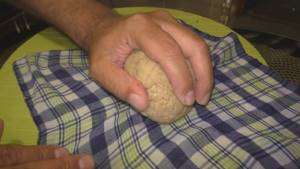
Each fisherman uses his own little tricks when preparing an irresistible fishing dish
It makes sense to talk about one way when hominy for fishing is prepared using:
- crumb of white bread;
- sweet cookies.
The mixture requires another secret additive - corn sticks.
To prepare food using original technology you need:
- pour boiling water over corn sticks;
- add crushed cookies;
- put the crumb of white bread.
You can add a drop of honey to enhance the taste. The mass needs to be mixed and the texture of the dough achieved.
Spring porridge recipes for various types of fish
Porridge for crucian carp
Crucian carp is a fish that can be found in almost any body of water. There is even such a category of fishermen as “crucian fishermen”. Crucian carp, like all cyprinids, may prefer corn porridge. It is prepared as follows:
- Take a pan and pour water into it and add corn grains, adding a teaspoon of sugar.
- The corn is cooked for at least 2 hours, with occasional stirring.
- Once ready, let it cool to room temperature. It is then passed through a meat grinder and mixed with animal feed.
- To make the porridge have an attractive aroma, you can add drops of anise, vanillin or chopped garlic to it.
Porridge for carp
A feeder like a spring is also used for carp fishing. Catch porridge can be prepared according to this recipe:
- 800 grams of peas are poured into a saucepan with water and cooked until smooth.
- While the porridge is cooling, take a bag of fried seeds and pass it through a meat grinder.
- 400 grams of semolina are gradually added to the cooled porridge with constant stirring.
- The porridge is stirred until it acquires the consistency of hard dough. After this, the crushed seeds are poured here.
- Finally, the whole mass is thoroughly mixed again.
The resulting porridge can be divided into several parts and placed in plastic bags. The porridge is stored for no more than 24 hours, after which it loses its attractive properties. In this regard, such porridge should not be prepared for long-term storage. It is suitable for one-time use.
Porridge for bream
Cooking porridge for bream does not have any special features, it just uses pearl barley, and it is prepared like this:
- Pour 3 glasses of water into the container and put on fire.
- When the water boils, pour several glasses of pearl barley into it. The pearl barley is cooked until it has absorbed almost all the moisture.
- Millet cereal, a tablespoon of vegetable oil and a little vanillin are also added here.
- The porridge is cooked until the remaining moisture disappears and small bubbling holes appear on the surface.
- The fire is turned off, and the porridge is removed from the stove and covered with a lid. The porridge should sit for half an hour.
- After the porridge has brewed and cooled, semolina, barley grits and corn grits are added to it, about one glass each, depending on the consistency.
- The porridge is thoroughly mixed.
Recipe for corn porridge with pumpkin
Corn porridge is healthy on its own, but if you add pumpkin to it, it becomes doubly healthy. For this dish you need:
- pumpkin pulp – 300-400 grams
- corn grits – 1 cup
- water – 3.5 cups (2.5 for porridge, a glass for pumpkin)
- honey and cream - 2 tablespoons each
- butter
Cook corn porridge until half cooked. Then simmer the pumpkin cut into pieces for at least 15 minutes with water, butter, honey and cream. Then place porridge and pumpkin in layers in a cauldron or ceramic pot, and then bake for at least half an hour in the oven, maintaining the temperature at 160 degrees.
Even those children who do not particularly like porridge will eat this dish with special pleasure.
Author: Elizaveta Kolyaeva
Features of spring fishing
Spring equipment
For effective fishing, it is necessary not only to have porridge that is tasty for fish, but also to properly equip the spring. At the same time, one should take into account the fact that the size of the spring is selected for a specific type of fish. For catching crucian carp, smaller springs are suitable, but for catching bream, and especially carp, you need to choose more massive products. Universal equipment looks like this:
- The main additional element of each rig is a leash with a hook. There can be several of them in this equipment, from 2 to 6 pieces, about 5 cm long. The leashes must be strong and flexible. The main material is braided or nylon thread.
- The size of the hooks is also selected depending on the size of the expected prey. As a rule, these are sizes No. 4-9.
- Sometimes additional weight is used, so the leashes are attached directly to the spring.
- Additional sinkers can weigh from 30 to 50 grams. As a rule, sinkers are attached to the end of the fishing line, and after it several springs are attached with leads attached to them.
- The length of the rod can be about 3.5 meters, with a dough of at least 40 grams.
- The reel must have at least 100 meters of fishing line wound on it, with a thickness of 0.25 to 0.3 mm.
- The moment of a bite can be caught by the tip of the rod, but it is better to use a bite alarm, either simple or electronic.
- The reel is a spinning reel, size 3000-4000, with a baitrunner function.
Types of springs
There are 3 main types of springs, differing in shape, size and installation features. These include:
- The first type is a “donut”, which represents a long spring coiled into a ring (donut shape). As a result of folding, a ring with a diameter of up to 50 mm is obtained, while the spring has a diameter of about 15 mm. One common leash is attached to such a spring, and additional leashes are attached to it.
- The second type is a “harvester”, which has the shape of a conical spring. The leads are attached to the top of the cone. This type of equipment is compact in size and easy to use, so it can be recommended for beginner fishermen.
- The third type is the “crucian carp killer,” which differs in the method of installation. To eliminate the additional weight, 3 springs are attached one after another. Each spring has its own leash with a hook. The distance between them is 12 cm. In some cases, especially when fishing in the current, it is still impossible to do without an additional sinker. It is attached to the very end of the main fishing line.
Spring fishing tips
Baits are selected taking into account many factors, such as the time of year, the preferences of the fish, as well as its type.
You can get good results if you use the following attachments:
- Fresh or canned green peas.
- Fresh or canned corn.
- Maggots.
- Bread crumb.
- Dung or earthworms.
- Insect larvae.
- Regular foam.
Spring with foam
Quite often, fishermen use foam, or rather foam balls mounted on hooks. This especially works when the reservoir has a very muddy bottom. A regular bait will sink into the mud before the fish even discovers it. As for the foam, it will be in the water column due to its buoyancy. Why fish bite on polystyrene foam is not known here; there are so many fishermen, so many opinions. The technique for fishing with foam is as follows:
- To begin with, the fishing point must be fed with porridge.
- A foam ball is placed on each hook, and the tip must be open.
- After this, the tackle is thrown into the desired place.
Fish can accidentally swallow polystyrene foam. There is one more assumption about this. The fish still knows that polystyrene foam is an inedible bait. If so, then it is garbage that needs to be removed. She puts the foam in her mouth and gets hooked. The fact is that the foam ball is always in the fish’s field of vision. Since it is not in one place, but moves to the sides under the influence of the current, this greatly irritates the fish, and it tries to get rid of this irritant. At this moment she gets hooked.
